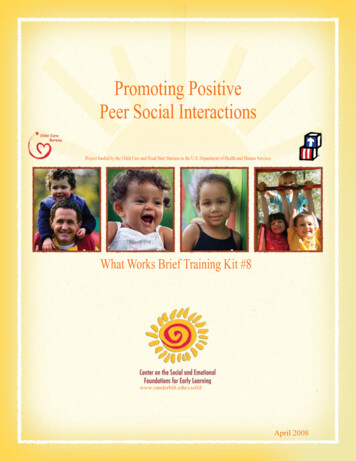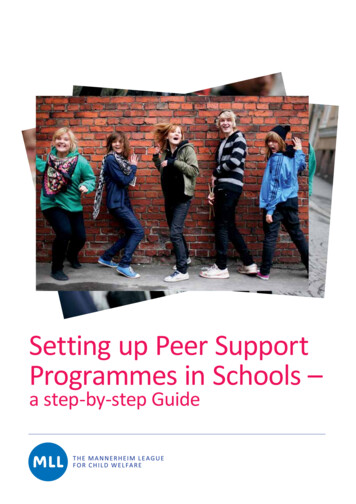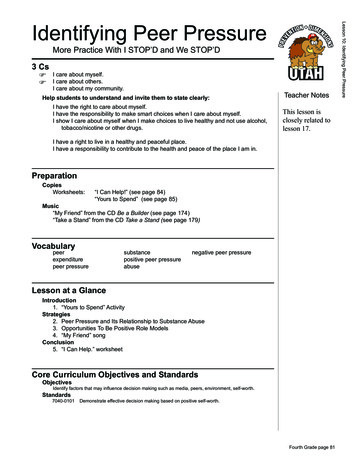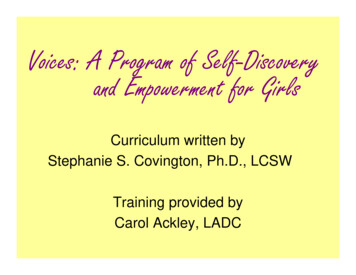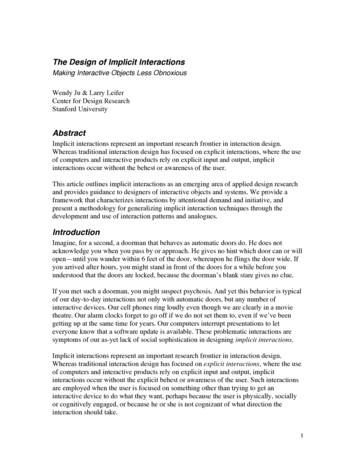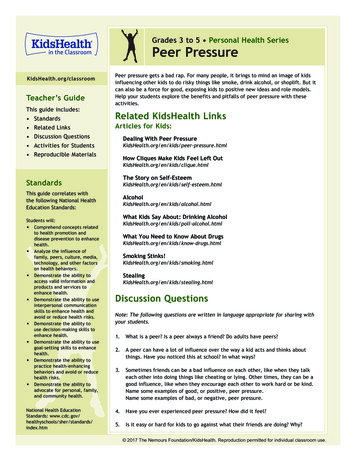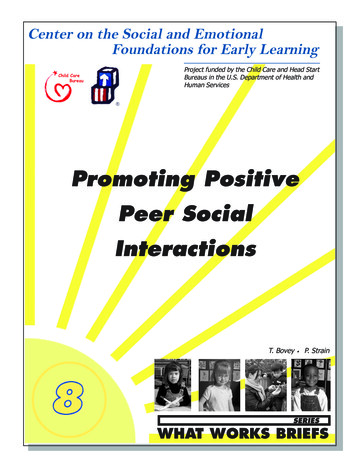
Transcription
Center on the Social and EmotionalFoundations for Early LearningProject funded by the Child Care and Head StartBureaus in the U.S. Department of Health andHuman ServicesPromoting PositivePeer SocialInteractionsT. Bovey P. StrainSERIESWHAT WORKS BRIEFS
Promoting Positive PeerSocial InteractionsThis What Works Brief is part of a continuing seriesof short, easy-to-read, “how to” informationpackets on a variety of evidence-based practices,strategies, and intervention procedures. The Briefsare designed to help teachers, parents, and othercaregivers support young children’s social andemotional development. They include examples andvignettes that illustrate how practical strategiesmight be used in a variety of early childhoodsettings and home environments.Throughout a typical preschool day, there are countless opportunities for children to interact and play with one another. Peerinteractions serve a variety of important roles for preschoolers. Throughout the day, as they watch, imitate, model, andinteract with each other, preschoolers learn to share, solve problems, and collaborate. They also build friendships that promotepositive social and emotional development. These skills don’t all come naturally, however, and some children have difficultyinteracting with their peers and building friendships. Some children must be taught the skills necessary to interact with theirpeers. At the Cherokee Trail Preschool, time is set aside during the daily large group or circle time to learn and practice specificsocial skills that children can use to interact and build friendships with one another.During circle time, Ms. Colleen takes out a poster and shows it to the children. “See this bug? He wants to get his friend’sattention. His friend isn’t looking at him. I bet you’ve all had times when you wanted to get a friend’s attention, but he or she didn’tlisten to you. Today, we’re going to learn something we can do to help get our friend’s attention. First, look at what the bug does.He looks at his friend. Then, he taps his friend on the shoulder. And then he says his friend’s name, ‘Johnny.’ And look, his friendturns around.” As Ms. Colleen describes the sequence of pictures on the poster, the children follow along.Ms. Colleen then re-creates this scenario for the children by acting it out with the help of Ms. Jody, the classroom assistant. First,Ms. Colleen demonstrates the right way to do the steps for the class. Then she demonstrates them again, purposely forgetting totap Ms. Jody on the shoulder. The children all point and shout out what she forgot to do, and Ms. Colleen corrects her mistake.Ms. Colleen then invites two children to the front of the group to try the strategy with each other, cuing them as needed to ensurethat they do all the steps. She goes on to remind the children that the teachers will be watching them during center time to see ifthey are using the skill when they need to get their friend’s attention. After circle time, the children choose centers and go off toplay. Ms. Colleen and the other caregivers watch closely to see if children use the strategy for Getting Their Friend’s Attention.The teachers provide positive feedback to children when they see them using the strategy.What Are Positive Social Interactions?Positive social interactions are interactions that take placebetween peers that are positive in nature and successful for bothchildren involved. These peer interactions are importantbecause they lead to positive social and emotional developmentin children. Research has shown that children who can interactsuccessfully with their peers, even during preschool, are morepopular, have stronger friendships, and are included more oftenin classroom activities than children who lack these skills.Children have many strategies that they use to interact with oneanother; some of these strategies are appropriate and some arenot. Most caregivers have seen children grab toys from peers,push or hit to get what they want, or ignore a friend who istrying to talk to them. Other children may have difficultyinteracting with peers because of developmental disabilities,language delays, or social delays. It is important to teachchildren positive skills that they can use to successfully interactwith their peers.Some skills that are useful for interacting with peers andbuilding social relationships include:Ö Getting a friend’s attentionÖ Sharing objectsÖ Asking peers to share objectsÖ Providing a play idea to a peerÖ Saying something nice to a friendChildren can be taught to initiate positive interactions with theirclassmates during large group activities such as circle time orstory time. Using role play and rehearsal (as Ms. Colleen did inthe example above), children learn to get each other’s attention,to share toys and materials, to make suggestions for play, toassist each other, and to say nice things to one another. Once agroup of children has been taught these positive social skills,teachers provide the children with opportunities throughout theday to interact with each other using the targeted skills. Duringthese play periods, caregivers circulate among the children,
encourage positive peer interactions (e.g., “Danielle, ask Joshuafor a paintbrush.”), praise interactions that occur (e.g., “Thankyou for handing Danielle a paintbrush.”), and providesuggestions to keep children’s play interesting (e.g., “You twocan finish painting the house together using the rollers.”).individual, ethnic, and cultural differences of the children in ateacher’s care.In addition to verbal praise, material reinforcers may be used toincrease the likelihood that positive peer interactions will takeplace again in the future. One such system is the use ofSuperstars. Superstars are necklaces the teachers and childrenhave made out of laminated construction paper and yarn. In theexample above, when Ms. Colleen or one of the other teachersobserves a child using a targeted social skill naturally duringplay, the teacher could reinforce this behavior by giving thechild a Superstar. The child is told exactly what he did to earnthe Superstar and then given the necklace to wear until the endof the day. During the last group activity of the day, children areResearch suggests that the use of positive social skills withpeers early on can lead to the development of positive peerrelationships, acceptance, and friendships. Although manychildren develop these positive social skills naturally, somechildren do not. Children who are withdrawn as well as youngchildren with mental retardation, autism, conduct problems, andemotional disturbances often have difficulty interactingappropriately with their peers and are thus at risk for later socialproblems. By teaching children appropriate social skills,providing them with willing and accepting peers to use theskills with, and creating opportunities for children to practicethese skills, teachers can improve all children’s socialbehaviors, potentially for a lifetime.Systematically embedding additional plannedsocial interactions throughout the classroomday provides increased opportunities forlearning positive social behaviors.invited up in front of the group to tell their friends what theydid to earn their “Superstar.”Caregivers should initially allocate 10 to 15 minutes a day forapproximately 2 weeks to teach peer interaction skills. Duringdaily peer play sessions that follow, adults can maintain highlevels of positive peer interactions by providing positivefeedback (through verbal praise and positive feedback) andsuggesting play ideas at least once per minute (e.g., “Whydon’t you hand Billy a block. Remember to look at him, taphim on the shoulder and say his name, then give him theblock.). Systematically embedding additional planned socialinteractions throughout the classroom day (e.g., passing outnames for jobs at circle, passing out napkins at snack) providesincreased opportunities for learning positive social behaviors.Who Are the Children Who HaveParticipated in Research on Teaching Peersto Promote Social Interactions?This strategy has been used to increase the positive peerinteractions of a wide variety of children, including 3- to 5year-olds who are typically developing; young children whoare withdrawn; and young children with mental retardation,autism, conduct problems, and emotional disturbances. Thistype of intervention has been used successfully across a widevariety of settings, including Head Start, inclusive child careprograms, and early childhood/special education settings.Moreover, this intervention has been used successfully withboys and girls from diverse racial, ethnic, and socioeconomicbackgrounds. When this intervention is conducted in inclusivesettings with children with special needs, typical children alsobenefit in that they become more accepting of children who aredifferent from them. As always, when looking at any strategy,care must be taken to make necessary adaptations to meet theWhy Is It Important to Teach Positive SocialSkills?Visiting Ms. Colleen’s classroom later in the year, we seechildren interacting and playing throughout the classroomand using positive social interactions naturally duringplay. At the sand table, two children are playing, but thematerials (shovels, buckets, etc.) have been purposefullylimited to encourage sharing. Jacob leans across the table,looks at his friend Max, taps him on the shoulder, and asksfor the shovel. Max takes one last scoop of sand, pours it inhis bucket, and hands the shovel to Jacob. In thehousekeeping area, children are playing Animal Hospitalwith stuffed animals and doctors’ equipment. Sierra iskeeping all the doctors’ tools in the bag and not lettingother children play the role of the doctor. The teachermonitoring the area simply states, “Remember to sharewith your friends.” Hearing this general prompt, Sierrareaches into the bag and takes out the stethoscope. Shethen looks at Juan, taps him on the shoulder, says hisname, and offers the stethoscope by holding it out andsaying, “Here.” Meanwhile, in the art area, Hannah isusing the easel to paint a picture. Ms. Colleen knows thatRichard (a child with a language delay) loves to paint alsobut hasn’t had a chance yet. She also knows that Richard isshy and that he won’t independently go and ask for a turn.So, Ms. Colleen brings Richard over to the easel andassists him in picking the art area picture from hiscommunication book, tapping Hannah on the shoulder, andhanding her the picture. Hannah looks at the picture andsays, “Oh, you want to paint.” She then hands him herpaintbrush. All of these examples illustrate positive peerinteractions. The teachers know that they will occasionallyneed to prompt children, as Ms. Colleen did with Richardor as Ms. Judy did with Sierra. But everyday, teachers seemore children using these important social skills with eachother naturally during play. In addition, the teachers havenoticed a decrease in negative peer interactions such asgrabbing, pushing, and name calling, and parents havecommented on their children’s use of the positive skillsat home.
http://csefel.uiuc.eduCenter on the Social and Emotional Foundations for Early LearningWe welcome your feedback on this What Works Brief. Please go to the CSEFEL Web site(http://csefel.uiuc.edu) or call us at (217) 333-4123 to offer suggestions.Where Do I Find Information on Implementing This Practice?See the CSEFEL Web site (http://csefel.uiuc.edu) for additional resourcesThere are many articles, books, and curricula that provide information on increasing peer interactions. For furtherinformation, see the following:Chandler, L. (1998). Promoting positive interaction between preschool-age children free play: The PALS center. Young ExceptionalChildren, 1(3), 14-19.LEAP Outreach Project. (2003). Nurturing social skills in the inclusive classroom: Staff workbook. Tualatin, OR: Teacher’sToolbox.Taylor, A. S., Peterson, C. A., McMurray-Schwarz, P., & Guillou, T. S. (2002). Social skills interventions: Not just for children withspecial needs. Young Exceptional Children, 5(4), 19-26.What Is the Scientific Basis for This Practice?For those wishing to learn more about the topic, the following resources provide more information:Dunn, J. & McGuire, S. (1992). Sibling and peer relationships in childhood. Journal of Child Psychology and Psychiatry andAllied Disciplines, 33, 67-105.Gottman, J. M. (1983). How children become friends. Monograph of the Society for Research in Child Development, 48 (3, SerialNo. 108).Landy, S. (2002). Pathways to competence: Encouraging healthy social and emotional development in young children. Baltimore:Brookes Publishing.Odom, S. L., Hoyson, M., Jamieson, B., & Strain, P. S. (1985). Increasing handicapped preschoolers’ peer social interactions:Cross-setting and component analysis. Journal of Applied Behavior Analysis, 18(1), 3-16.Odom, S. L., McConnell, S. R., McEvoy, M. A., Peterson, C., Ostrosky, M., Chandler, L. K., Spicuzza, R. J., Skellenger, A.,Creighton, M., & Favazza, P. C. (1999). Relative effects of interventions supporting the social competence of youngchildren with disabilities. Topics in Early Childhood Special Education, 19(2), 75-91.Odom, S. L., & Strain, P. S. (1986). A comparison of peer-initiation and teacher-antecedent interventions for promoting reciprocalsocial interaction of autistic preschoolers. Journal of Applied Behavior Analysis, 19(1), 59-71.Odom, S. L., Strain, P. S., Karger, M. A., & Smith, J. D. (1986). Using single and multiple peers to promote social interaction ofpreschool children with handicaps. Journal of the Division for Early Childhood, 10(1), 53-64.Strain, P. S., & Kohler, F. W. (1998). Peer-mediated social intervention for young children with autism. Seminars in Speech andLanguage, 19(4), 391-405.This What Works Brief was developed by the Center on the Social and Emotional Foundations for Early Learning.Contributors to this Brief were T. Bovey and P. Strain.This material was developed by the Center on the Social and Emotional Foundations for Early Learning with federal funds from the U.S. Department of Healthand Human Services, Administration for Children and Families (Cooperative Agreement N. PHS 90YD0119). The contents of this publication do not necessarilyreflect the views or policies of the U.S. Department of Health and Human Services, nor does mention of trade names, commercial projects, or organizationsimply endorsement by the U.S. Government. You may reproduce this material for training and information purposes.Promoting Positive Peer Social InteractionsWHAT WORKS BRIEFS
Promoting PositivePeer SocialInteractionsHANDOUT8Teach peers positive social interactions during daily large groupactivities.Circle time or story time usually provides good opportunities to take a few minutes to teach these skills.Skills are taught by:999999Explaining the skillDemonstrating the correct way to use itDemonstrating an incorrect way and letting the children figure out what step was missingLetting a child practice a skill with an adultLetting a child practice a skill with another childProviding positive feedback and attention on use of the skillsThe target social skills are:99999Getting a friend’s attentionSharing objectsAsking peers to share objectsProviding a play idea to a peerSaying something nice to a friendMonitor playtime for naturally occurring positive peer socialinteractions.Teachers should be actively moving around the classroom, interacting with children during play, and looking forchildren using the targeted social skills. Additionally, teachers should be ready to provide assistance to children asneeded so they can interact successfully with their peers.Provide cueing as needed by reminding children to:999Play togetherShare with their friendsBe persistentProvide additional assistance to children as needed to ensure that peersocial interactions are successful. For example:999ModelingSpecific verbal cues (e.g., Remember to tap him on the shoulder)Physical assistanceProvide positive attention to children who are using targeted socialskills naturally with:99Positive feedback and attentionSuperstar SystemThis material was developed by the Center on the Social and Emotional Foundations for Early Learning with federal funds from the U.S. Department of Healthand Human Services, Administration for Children and Families (Cooperative Agreement N. PHS 90YD0119). The contents of this publication do not necessarilyreflect the views or policies of the U.S. Department of Health and Human Services, nor does mention of trade names, commercial projects, or organizationsimply endorsement by the U.S. Government. You may reproduce this material for training and information purposes.
attention. His friend isn't looking at him. I bet you've all had times when you wanted to get a friend's attention, but he or she didn't listen to you. Today, we're going to learn something we can do to help get our friend's attention. First, look at what the bug does. He looks at his friend. Then, he taps his friend on the shoulder.
